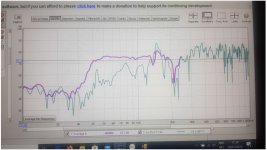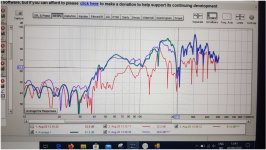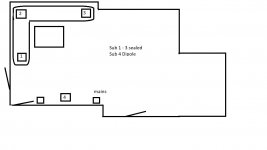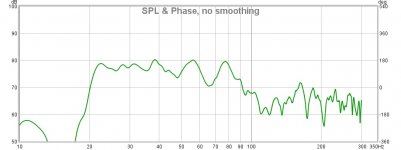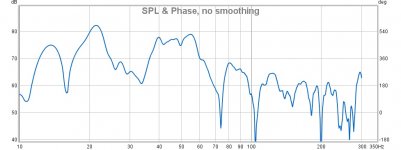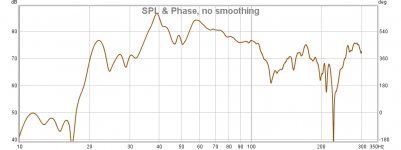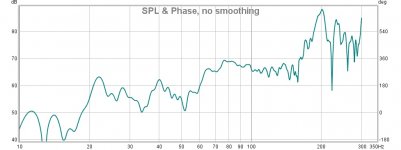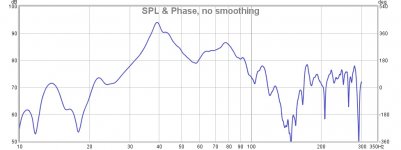After reading most of this thread, the whitepapers and trying to generally learn some acoustic principles, this is what I managed for first try. There are serious limitations since this is the family living-room, and scattered "sound-boxes" all around is not too welcome by the better half, but also the room has few options in regards to free space and variations in placements. Room is around 35m2
System consists of three small sealed cabs with low profile 10" positioned under the sofa, plus one H-frame dipole centered between the speakers. MiniDSP 2x4HD and two power-amps. Too much compromises to achieve any "perfection" but when I had a few go's at the setup I got bass that impressed me quite much. XTZ speakers, too close to front wall, 6,5" vented with some stuffing in ports
What surprised me was what looked great in REW sounded like a dreadful, incoherent and muddy mess. This was with individual delay. New try without delay, but could not get a very smooth FR, but this sounded better than any other "living-room" hifi I have heard as I can remember. Not perfect, but engaging and quite precise
First picture: Thick Purple = average four seats in sofa / green = speakers only at best listening pos.
Second picture: Thick green = average four seats in sofa / purple best listening pos. / red = speakers only at best listening pos.
System consists of three small sealed cabs with low profile 10" positioned under the sofa, plus one H-frame dipole centered between the speakers. MiniDSP 2x4HD and two power-amps. Too much compromises to achieve any "perfection" but when I had a few go's at the setup I got bass that impressed me quite much. XTZ speakers, too close to front wall, 6,5" vented with some stuffing in ports
What surprised me was what looked great in REW sounded like a dreadful, incoherent and muddy mess. This was with individual delay. New try without delay, but could not get a very smooth FR, but this sounded better than any other "living-room" hifi I have heard as I can remember. Not perfect, but engaging and quite precise
First picture: Thick Purple = average four seats in sofa / green = speakers only at best listening pos.
Second picture: Thick green = average four seats in sofa / purple best listening pos. / red = speakers only at best listening pos.
Attachments
Last edited:
Thank you Dr. Geddes...
I don't understand how the quality of the subs used affects the outcome. ... In your discussions you favor much larger subs than I would be able to use. I was going down the path of searching for subs with a small form factor but still having a reputation for detail articulation and range....this of course is attributed to a single sub...does it matter with multiple? Is it better to have one larger, more dynamic sub if possible and two small ones? Any thoughts on how to think about this would be appreciated. Thank you.
I can't make specific recommendations without a detailed analysis of the setup, and I don't have the ambition to get into the details. But here are some generalizations:
I have found that in general the subs don't all play at the same level, hence output capability would not need to be the same either. Hence a "bigger to smaller" mix would be appropriate. As far as "sub quality" goes, I don't give that much credence - all long as the sub is not being overloaded (which is far easier and more common than most people think) all subs are about the same to me. Just be sure that none of them are being overloaded and you will be fine.
Why do you have the subs playing out that far? Where do you cross your speakers at? I’ve had best results rolling off the subs at 70hz. By 100 the speakers blend into them.
My subs go above 100 Hz, what is the problem? And there is no "crossover." everything blends together.
My subs go above 100 Hz, what is the problem? And there is no "crossover." everything blends together.
Show us the graph of your subs playing with your mains. There is usually a mess in the 100-150 hz range where they are interacting with each other. You don’t need the subs past 100 if your speakers are capable of that. It doesn’t sound as clean either. Too bassy.
Like Gedlee states, there are no crossover. The subs all have LP, but at different frequencies. I have not experienced the blending above 100Hz to be an issue at all, but it took a lot of testing before subs blended nicely with mains. The measurements are from last summer and after these attempts I have since changed the speakers twice and have every time managed to blend the subs well, but FR in REW does not always look super smooth.
Is there any general rule in regards to using individual delay in MiniDSP? On my first attempt I just added delay individually until curve was on its smoothest, but adding around 12ms delay, I guess is equal to one whole wavelength around 80Hz. So my notion is that cant be too successful.
Is there any general rule in regards to using individual delay in MiniDSP? On my first attempt I just added delay individually until curve was on its smoothest, but adding around 12ms delay, I guess is equal to one whole wavelength around 80Hz. So my notion is that cant be too successful.
I use 4 subs, but only have one big amplifier for subwoofers. So I've made a trick where I run two subs on each channel, and with longer wires, I can move the subs to make kinda of a physical EQ. I have an 8 channel DSP Pre-amp - but use 6 channels for 3 way mains. So I can still do EQ on the left and right subwoofer pair - including individual slopes and PEQ's . But mostly I find that dampening my room-mode at 41hz on all subs and giving them a 48LR at 80hz and letting my mains run to 60hz with 12LR - works quite nicely. I do have a DSP ready, when I get the time to build another amp, to make full control individually on all 4 subs - with time it'll comeIs there any general rule in regards to using individual delay in MiniDSP? On my first attempt I just added delay individually until curve was on its smoothest, but adding around 12ms delay, I guess is equal to one whole wavelength around 80Hz. So my notion is that cant be too successful.
I measure with all 4 subs and woofers on the mains at the same time, in the listening position - to see if I get it right. How do you do it?
I measure with all 4 subs and woofers on the mains at the same time, in the listening position - to see if I get it right. How do you do it?
Do you use sweeps or some kind of RTA? I set up my mike stand at LP/ear height and do sweeps at multiple listening locations in the sofa, then I average this and start by blending sub closest to mains. Mains always full range. So I do multiple sweeps between every change I do, and just try out a bunch of LP frequencies, filter types, phase inversion and so on, until I get the smoothest looking FR, then I move on to next sub, just trying a bunch of settings till it looks right
I use a Groundsound DCN28 DSP. It uses a software similar to REW/Holm and the like. I use slow sweeps with all subs and woofers, to both find the room-mode and the balance/level/blending with mains. My mains and subwoofers are big enough(plenty of headroom), so that I can find the settings that does not have any suckout/cancellations - then I dampen the rest. I usually don't average, because if the bass is good in one place around the listening position - it's usually good everywhere - that's the beauty if you have many subs.
Looks like a nice piece of kit. Are they out of business? Wish I had the possibility to go bigger, both in mains and subs but for now I have to work with what I have. How big is your mains?
I guess one of the downfalls of my setup are that I am stuck with placing the subs in one half of the room (under sofa), so I probably can never achieve proper smoothing of room modes. Maybe I could post measurements of all sources individually, and you could help me understand where my setup needs most attention?
I guess one of the downfalls of my setup are that I am stuck with placing the subs in one half of the room (under sofa), so I probably can never achieve proper smoothing of room modes. Maybe I could post measurements of all sources individually, and you could help me understand where my setup needs most attention?
At the moment yes. But maybe it will be back - which I hope - cause I love the complete package.
My mains have 2 SB23NX 8" woofers in closed boxes pr. side. Subs are 4 x 95 liters closed boxes with 12" XXLS 830952 Peerless drivers with around 1400W in front.
Yes - you could try to post them. I do not promise anything But try
But try
My mains have 2 SB23NX 8" woofers in closed boxes pr. side. Subs are 4 x 95 liters closed boxes with 12" XXLS 830952 Peerless drivers with around 1400W in front.
Yes - you could try to post them. I do not promise anything
Last edited:
Nice! I wish I could experience a system of that magnitude some day. How do you like those 8" mains? I have a notion sealed mains with 8" or larger would be satisfactory, more than your average 6" ported like most I know have. Some smallish monitors with 12" sealed are in the planning stage, and I think those would go nicely with multiple subs. Do you know how it affects the blending of sealed subs and ported mains? They have different roll-off characteristics, so phase responses would be harder to match perhaps?
I'll dig in my measurements and find the individual results and post them. Might take a few days though. Thanks
I'll dig in my measurements and find the individual results and post them. Might take a few days though. Thanks
Lalaland: Try play with the inbuilt room simulation in REW. The tool it awesome to give you a grasp of what is going on, when moving subs around the room. Flipping phase, changing delay, crossover and so on. You Can also chance the F3 of the subs and mains. Bonus is that it Can simulate multiple seat variation on the fly.
Like Gedlee states, there are no crossover. The subs all have LP, but at different frequencies. I have not experienced the blending above 100Hz to be an issue at all, but it took a lot of testing before subs blended nicely with mains. The measurements are from last summer and after these attempts I have since changed the speakers twice and have every time managed to blend the subs well, but FR in REW does not always look super smooth.
Is there any general rule in regards to using individual delay in MiniDSP? On my first attempt I just added delay individually until curve was on its smoothest, but adding around 12ms delay, I guess is equal to one whole wavelength around 80Hz. So my notion is that cant be too successful.
I don't use delay on the subs at all, I don't see the need. At these frequencies all you need to worry about is phase. And I agree with everything that you have said above. And yes, it can take a lot of measurements.
But I have found this, that using the "optimizers" is fine for a start, but the measurements were still not as good as basing the changes on the measurements. You can get a pretty decent response that way. It does take individual control over each sub though.
One thing that I will note, in addition to what you said, is that, in my system, the nearest sub is the highest and the most wide band - barely above 100 Hz., so its blends well into the mains. The other two fill in spots in the lows and highs and are at much lower bandwidth and level.
Thanks for your input. You say phase is important, does that mean it would be smart to study phase plots in addition to FR? Maybe look for phase shifts when blending subs or is it as I have read, that smooth FR means no big phase-shifts?
Posted some measurements from listening pos. All is taken with mike in one spot
Posted some measurements from listening pos. All is taken with mike in one spot
Attachments
I just mean relative phase between the subs. Changing phase, either by polarity or phase shift, can have huge effects on the combined response. It's all about how all these sources add up at the listener that matters - specifics aren't important as long as the solution works to smooth the response.
Sub 1 is clearly going to be the dominate one owing to its already smooth response (unless its low output limits its ability to be the main sub.) Then you'll need something to fill in the deep hole at 150 Hz because sub 1 can't do that.
Sub 1 is clearly going to be the dominate one owing to its already smooth response (unless its low output limits its ability to be the main sub.) Then you'll need something to fill in the deep hole at 150 Hz because sub 1 can't do that.
Got it! I'll have another go as soon as I can have the house to myself for a round of measurements.
Sub output is indeed limited as you point out. They have a chunk of boost down low(a la Linkwitz transform), just to get some output down to 20hz. Without boost they roll off at around 40hz but output is off course up.
That big hole around 150hz was the reason I made the dipole (Sub 4). Another issue is the big peak at 40hz from the mains. I have no EQ on them, so maybe some stuffing in ports or some other trick is needed
Sub output is indeed limited as you point out. They have a chunk of boost down low(a la Linkwitz transform), just to get some output down to 20hz. Without boost they roll off at around 40hz but output is off course up.
That big hole around 150hz was the reason I made the dipole (Sub 4). Another issue is the big peak at 40hz from the mains. I have no EQ on them, so maybe some stuffing in ports or some other trick is needed
Earl, what are your thoughts on tactile sensation (felt impact) from subwoofers, and the time domain?
It seems to me that tactile sensation is sensed by the skin moreso than the ears themselves. There is a time delay associated with nerve propagation speed and the amount of delay varies with distance from the brain, such that impact sensations in the chest will arrive before impact sensations in the legs. Apparently there is also a time window within which impact sensations are perceptually fused into a single event, as we are not aware of the nerve impulse arrival time differences.
From time to time I've poked around online a bit trying to find relevant information and recall reading a paper about synchronizing the tactile sensations from a butt shaker with the explosion sounds delivered through headphones for video game applications. Best perceptual results were when the butt shaker fired about ten milliseconds before the explosion sound, presumably resulting in the arrival of the nerve impulses from the butt reaching the brain in synch with the transients from the explosion.
With a subwoofer system, are tactile sensations primarily a "first-arrival" phenomenon? It seems to me like they might be, or at least there might be a perceptual "time window" for tactile sensations of impact, as I think about the tactile sensation from a shock wave outdoors. If so, does that have any implication for multiple subwoofer set-up?
This thought just occurred to me - [hand waving] dipoles seem to have less perceived impact than monopoles even when they have comparable measured frequency response, could that be because enough reversed-phase backwave energy arrives within the "time window" for tactile sensation perception to dilute the sensation? [/hand]
Thanks!
It seems to me that tactile sensation is sensed by the skin moreso than the ears themselves. There is a time delay associated with nerve propagation speed and the amount of delay varies with distance from the brain, such that impact sensations in the chest will arrive before impact sensations in the legs. Apparently there is also a time window within which impact sensations are perceptually fused into a single event, as we are not aware of the nerve impulse arrival time differences.
From time to time I've poked around online a bit trying to find relevant information and recall reading a paper about synchronizing the tactile sensations from a butt shaker with the explosion sounds delivered through headphones for video game applications. Best perceptual results were when the butt shaker fired about ten milliseconds before the explosion sound, presumably resulting in the arrival of the nerve impulses from the butt reaching the brain in synch with the transients from the explosion.
With a subwoofer system, are tactile sensations primarily a "first-arrival" phenomenon? It seems to me like they might be, or at least there might be a perceptual "time window" for tactile sensations of impact, as I think about the tactile sensation from a shock wave outdoors. If so, does that have any implication for multiple subwoofer set-up?
This thought just occurred to me - [hand waving] dipoles seem to have less perceived impact than monopoles even when they have comparable measured frequency response, could that be because enough reversed-phase backwave energy arrives within the "time window" for tactile sensation perception to dilute the sensation? [/hand]
Thanks!
Last edited:
- Home
- Loudspeakers
- Subwoofers
- Multiple Small Subs - Geddes Approach
